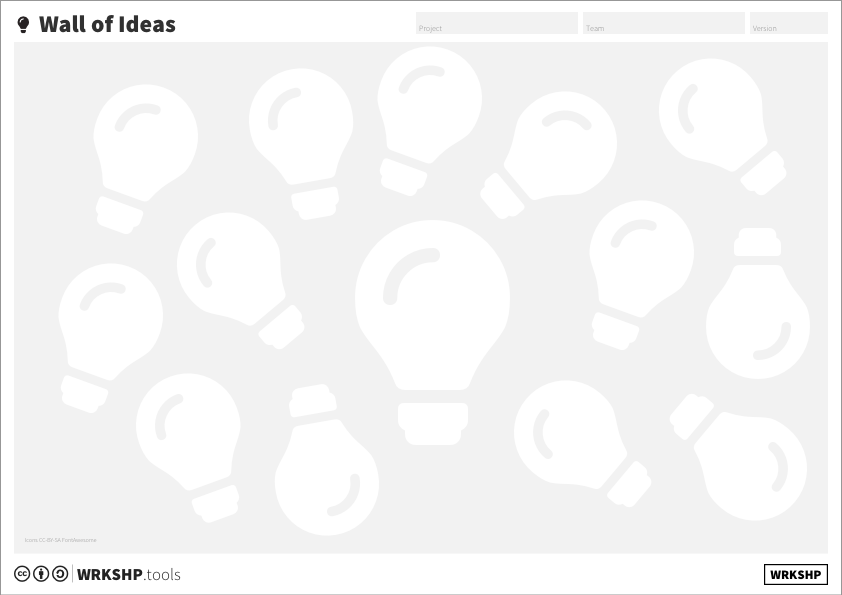Wall of Ideas
The purpose of this tool is to fill up an entire wall with the ideas generated by a team in a short amount of time.
Use this tool when:
- you want to quickly generate 100+ ideas for possible solutions
- you want to come up with directions for a solution you can test with customers
Overview
| Time | ± 30 minutes | |
| Difficulty | 2 / 5 | |
| People | 3 - 10 | |
| Author | erik van der pluijm | |
| Website | https://designabetterbusiness.tools | |
| License | CC BY SA 4.0 |

What is it and when should I use it?
The purpose of this tool is to fill up an entire wall with the ideas generated by a team in a short amount of time.
This technique uses trigger questions to get the creative juices flowing. Asking 'what if?' is a powerful way to fill a wall with great ideas. Ask the trigger questions to your team in a fast pace, challenging each person to create lots of ideas.
Using time pressure and a sense of competition (who added the largest number of post-its?) make it easier to shake any creative blocks. In groups of around 10 people, it is doable to reach more than 200-300 ideas in half an hour! From those ideas, there will always be a few that are truly new and interesting. You just need to get past the ideas everyone else already had first…
Tip! To incentivise people to generate more ideas, assign a point for each sticky note. The highest total score wins.
Asking people to describe their idea as they fasten their sticky notes to the wall is a great way to get everyone, from the introverts to the extroverts, working together creatively and feeling a sense of achievement. As each team member adds ideas to the wall, the rest of the team will no doubt come up with new ones or point out ones that are funny or interesting.
Tool Overview

Ideas Place your ideas on the canvas
Steps
1 Prepare
The wall of ideas requires preparation. First, decide on a list of trigger questions that you’re going to ask the team in rapid succession (one every 30 seconds or so). Use the What If questions list supplied with the course to get you started, taking out the ones that don’t apply to your business. You can find a selection of trigger questions to start with below.
2 Trigger Questions
Good trigger questions help you make new connections, and help you to think in a 'what if' mindset. It is perfectly possible to make trigger questions based on for instance your business model, customer journey, persona, or vision. The process will be always the same, and it will help you come up with a lot of options. You'll probably need around 20-40 questions at least.
Use your existing business model canvas, feedback from earlier experiments, design criteria, context canvas, etc. as fodder for creating new questions. If, for instance, you sell a product today through retailers, what would happen if you sold it directly to customers through an online channel? What would that look like? You get the picture.
3 Diverging: Asking Trigger Questions
Have the team members sit individually, with a stack of empty post-its and a good marker. Explain that when the exercise starts, you will ask a question every 10-15 seconds or so. They should write down everything that they think of, and fill as many post-it notes as possible. At this stage, there are no bad ideas. Every idea is a stepping stone that leads you to the next.
Then, when everyone is ready, set a timer for 15 minutes (you can always do a second run, it's better to do two short runs than one longer one). Let the timer tick down, and keep asking trigger questions every 10-15 seconds. Slowly repeat the trigger questions a couple of times, or come up with variations on the spot.
Tip! When people seem to not write, or get stuck, remind them that it’s about getting as many ideas as possible in this stage. Judging comes later.
As the trigger questions are asked, each person will simply write whatever comes to mind on a sticky note using a permanent marker. By the end of this exercise there should be a pile of at least as many sticky notes as there are questions in front of each participant.
4 Sticking it on the wall
Once the questions run out, have everyone stick their sticky notes to the wall, one at a time, calling out the idea. Make sure everyone is clear about what’s been added. Don’t worry about organisation too much at first, but whenever someone has had the same idea or a similar one, try to stick them together in the same general area.
5 Converging: Clustering your ideas
There will be way too many ideas on the wall to make sense of, so the next step is, to organise the ideas into a maximum of ~5 high-level clusters.
You can define the clusters beforehand, or you can use affinity mapping and let them emerge.
Have the team members work on the clustering together, and silently cluster them. The point is that they do not talk or discuss the ideas, but simply move them around. If you notice a sticky note that can't find a good home, put it to the side, or agree to disagree.
6 Next Steps
When you’re done clustering, record your result. Photos make it easy to do that. Send them around to the team and don’t forget to keep them informed of future progress!